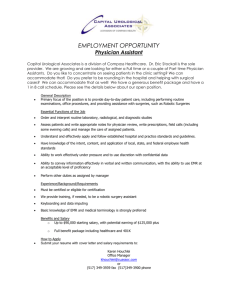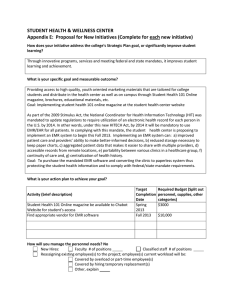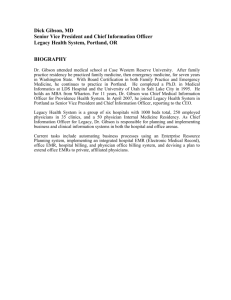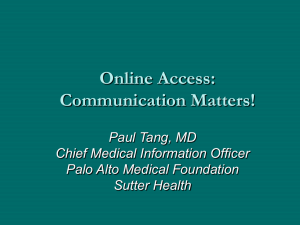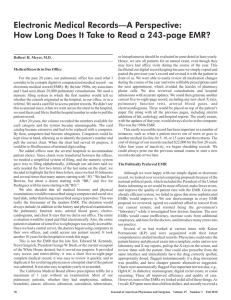Health Information Technology
advertisement
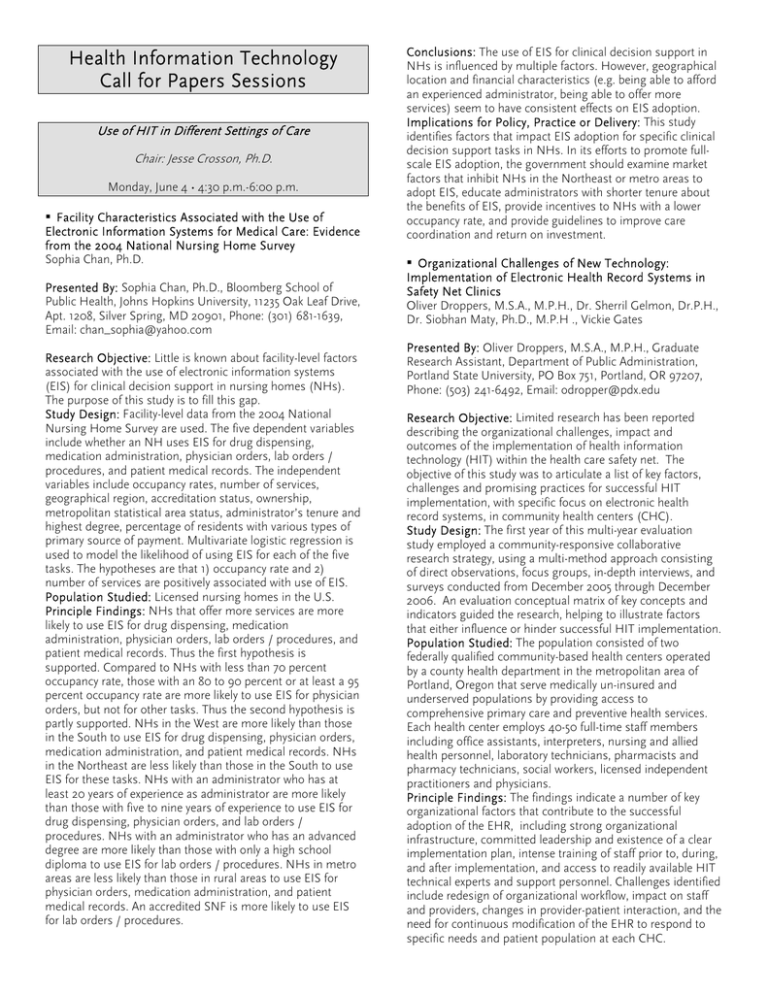
Health Information Technology Call for Papers Sessions Use of HIT in Different Settings of Care Chair: Jesse Crosson, Ph.D. Monday, June 4 • 4:30 p.m.-6:00 p.m. Facility Characteristics Associated with the Use of Electronic Information Systems for Medical Care: Evidence from the 2004 National Nursing Home Survey Sophia Chan, Ph.D. Presented By: Sophia Chan, Ph.D., Bloomberg School of Public Health, Johns Hopkins University, 11235 Oak Leaf Drive, Apt. 1208, Silver Spring, MD 20901, Phone: (301) 681-1639, Email: chan_sophia@yahoo.com Research Objective: Little is known about facility-level factors associated with the use of electronic information systems (EIS) for clinical decision support in nursing homes (NHs). The purpose of this study is to fill this gap. Study Design: Facility-level data from the 2004 National Nursing Home Survey are used. The five dependent variables include whether an NH uses EIS for drug dispensing, medication administration, physician orders, lab orders / procedures, and patient medical records. The independent variables include occupancy rates, number of services, geographical region, accreditation status, ownership, metropolitan statistical area status, administrator’s tenure and highest degree, percentage of residents with various types of primary source of payment. Multivariate logistic regression is used to model the likelihood of using EIS for each of the five tasks. The hypotheses are that 1) occupancy rate and 2) number of services are positively associated with use of EIS. Population Studied: Licensed nursing homes in the U.S. Principle Findings: NHs that offer more services are more likely to use EIS for drug dispensing, medication administration, physician orders, lab orders / procedures, and patient medical records. Thus the first hypothesis is supported. Compared to NHs with less than 70 percent occupancy rate, those with an 80 to 90 percent or at least a 95 percent occupancy rate are more likely to use EIS for physician orders, but not for other tasks. Thus the second hypothesis is partly supported. NHs in the West are more likely than those in the South to use EIS for drug dispensing, physician orders, medication administration, and patient medical records. NHs in the Northeast are less likely than those in the South to use EIS for these tasks. NHs with an administrator who has at least 20 years of experience as administrator are more likely than those with five to nine years of experience to use EIS for drug dispensing, physician orders, and lab orders / procedures. NHs with an administrator who has an advanced degree are more likely than those with only a high school diploma to use EIS for lab orders / procedures. NHs in metro areas are less likely than those in rural areas to use EIS for physician orders, medication administration, and patient medical records. An accredited SNF is more likely to use EIS for lab orders / procedures. Conclusions: The use of EIS for clinical decision support in NHs is influenced by multiple factors. However, geographical location and financial characteristics (e.g. being able to afford an experienced administrator, being able to offer more services) seem to have consistent effects on EIS adoption. Implications for Policy, Practice or Delivery: This study identifies factors that impact EIS adoption for specific clinical decision support tasks in NHs. In its efforts to promote fullscale EIS adoption, the government should examine market factors that inhibit NHs in the Northeast or metro areas to adopt EIS, educate administrators with shorter tenure about the benefits of EIS, provide incentives to NHs with a lower occupancy rate, and provide guidelines to improve care coordination and return on investment. Organizational Challenges of New Technology: Implementation of Electronic Health Record Systems in Safety Net Clinics Oliver Droppers, M.S.A., M.P.H., Dr. Sherril Gelmon, Dr.P.H., Dr. Siobhan Maty, Ph.D., M.P.H ., Vickie Gates Presented By: Oliver Droppers, M.S.A., M.P.H., Graduate Research Assistant, Department of Public Administration, Portland State University, PO Box 751, Portland, OR 97207, Phone: (503) 241-6492, Email: odropper@pdx.edu Research Objective: Limited research has been reported describing the organizational challenges, impact and outcomes of the implementation of health information technology (HIT) within the health care safety net. The objective of this study was to articulate a list of key factors, challenges and promising practices for successful HIT implementation, with specific focus on electronic health record systems, in community health centers (CHC). Study Design: The first year of this multi-year evaluation study employed a community-responsive collaborative research strategy, using a multi-method approach consisting of direct observations, focus groups, in-depth interviews, and surveys conducted from December 2005 through December 2006. An evaluation conceptual matrix of key concepts and indicators guided the research, helping to illustrate factors that either influence or hinder successful HIT implementation. Population Studied: The population consisted of two federally qualified community-based health centers operated by a county health department in the metropolitan area of Portland, Oregon that serve medically un-insured and underserved populations by providing access to comprehensive primary care and preventive health services. Each health center employs 40-50 full-time staff members including office assistants, interpreters, nursing and allied health personnel, laboratory technicians, pharmacists and pharmacy technicians, social workers, licensed independent practitioners and physicians. Principle Findings: The findings indicate a number of key organizational factors that contribute to the successful adoption of the EHR, including strong organizational infrastructure, committed leadership and existence of a clear implementation plan, intense training of staff prior to, during, and after implementation, and access to readily available HIT technical experts and support personnel. Challenges identified include redesign of organizational workflow, impact on staff and providers, changes in provider-patient interaction, and the need for continuous modification of the EHR to respond to specific needs and patient population at each CHC. Conclusions: To date, the two health centers have experienced a high level of success with adoption and implementation of the EHR. The organizational capacity for effective change management is critical to the success of any HIT system. It is clear that there is a significant learning curve associated with the initial and ongoing use of the EHR. Having sufficient organizational capacity and ability to respond and adapt rapidly to barriers and changes as they are encountered is vital for the initial and sustained operations in community health centers. Implications for Policy, Practice or Delivery: The use of HIT can potentially improve the overall quality of patient care provided by a CHC as well as enhanced organizational functions, through increased ease in accessibility of patients’ medical records, improved legibility, reduction in errors, improved processes for patient follow-up, tracking events, patient referrals, ordering and accessibility of lab results, and enhancement of patient satisfaction. Further understanding of the key organizational factors identified in this study can be used by similar organizations when planning to adopt an EHR or similar HIT system within the safety net context. Funding Source: Kaiser Permanente Community Benefit Fund Provider and Patient Opinions on Technology Assisted Patient Reported Outcomes Tami Mark, Ph.D., M.B.A., Barry Fornter, Ph.D., Gina Johnson, M.S.N., A.P.R.N. Presented By: Tami Mark, Ph.D., M.B.A., Associate Director, Thomson Medstat, 4301 Connecticut Avenue, NW Suite 330, Washington, DC 20008, Phone: (202) 719-7832, Fax: (202) 719-7801, Email: Tami.Mark@thomson.com Research Objective: The Patient Assessment, Care & Education (PACE) SystemTM was designed to address the persistent problem of under-identification and treatment of chemotherapy-related symptoms. The PACE SystemTM uses a pen-based e/Tablet that operates off a wireless network. Cancer Support NetworkTM (CSN) on the e/Tablet provides educational materials to patients in text, video, audio, and graphic format. The PACE System™ also administers the Patient Care MonitorTM(PCM), a psychometrically validated, patient-reported symptom severity screening scale that generates a real-time, point-of-care report for the provider. The aim of the study was to evaluate The PACE System™ ---- an electronic patient symptom screening and reporting system for oncology. Specifically, the study determined provider and patient opinions of The PACE System™ and documented evidence as to whether symptom assessment rates increased after The PACE System™ was implemented. Study Design: Ninety-two providers (i.e., physicians, nurse practitioners, physician assistants) at 16 community oncology clinics were surveyed about their experiences with The PACE System™. In addition, 100 patients at two community oncology clinics were surveyed about their perceptions of The PACE System™. Finally, at two oncology clinics 100 patient charts were abstracted in the year prior to implementation of The PACE System™ and 100 patient charts were abstracted in the year after the implementation The PACE System™ to determine symptom assessment rates. Population Studied: Patients treated in community oncology centers. Principle Findings: The majority of patients reported that they were generally satisfied with the PCM (55%). Slightly more than half indicated that it helped them to remember symptoms (53%) and 44% said it encouraged them to discuss their symptoms with their provider. 91% of respondents said the e/Tablet was easy to use and the vast majority (90%) also said it was easy to read. 79% of patients would recommend The PACE System™ to other patients. Providers seemed to value the PCM Report. The majority of providers thought that the PCM increased the frequency with which symptoms were identified and treated. Almost 60% indicated that the PCM helped a lot with allowing for aggressive treatment of symptoms, and almost 50% reported that the PCM helped them to aggressively treat under-reported symptoms. The results from the chart review at two sites show statistically significant increases in the assessment rates for depression, pain, and fatigue after The PACE System™ was implemented. Prior to implementation of The PACE System only 9% of patients were assessed for depression, as compared to 73% after implementation. Assessment of fatigue increased by 29 percentage points, from 63% of patients to 92%. Assessment of pain increased by 21 percentage points, from 76% of patients to 97%. Examining each site separately revealed that at Site A saw an increased in screening rates for all three symptoms. At Site B screening rates for depression increased substantially, but there was a slight decline in screening rates for fatigue and pain. Conclusions: The PACE System™ appears to be a promising approach to addressing the widespread problem of underidentification and treatment under-treatment of symptoms in patients undergoing cancer treatment. Implications for Policy, Practice or Delivery: Payers may want to encourage the adoption of IT screening technologies in oncology clinics as a way to improve the quality of care being provided. Funding Source: RWJF Features of Electronic Medical Records Used in Ambulatory Care Settings in 2005 Esther Hing, M.P.H., Catharine W. Burt, Ed.D. Presented By: Esther Hing, M.P.H., Survey Statistician, Department of Health and Human Services, National Center for Health Statistics, 3311 Toledo Road, Room 3409, Hyattsville, MD 20782, Phone: (301)458-4271, Fax: (301)4584693, Email: ehing@cdc.gov Research Objective: Although there has been progress in electronic medical record (EMR) adoption among ambulatory care providers, less is known about the functionalities of EMR systems in use. This paper examines both use of EMRs among office-based physicians and in hospital emergency and outpatient departments in 2005, as well as features included in these EMRs including patient demographic information, physician and nurse notes, lab test results, computerized test order entry, computerized prescription order entry, clinical reminders for screening test and guideline-based interventions, and public health reporting. We also examine use of fully functioning EMRs as defined by four minimally required functions (lab test results, computerized test order entry, computerized prescription order entry, and physician notes). Study Design: The National Ambulatory Medical Care Survey is a nationally representative cross-sectional sample survey of non-federal office-based physicians providing patient care, excluding anesthesiologist, radiologists, and pathologists. The National Hospital Ambulatory Medical Care Survey is a nationally representative cross-sectional sample of emergency and outpatient departments in non-federal short-stay hospitals. Hospital, physician, and physician practice characteristics associated with EMR use were analyzed using Chi-square tests and logistic regression models. Population Studied: Office-based physicians (n=1281), hospital emergency departments (n=345) and outpatient departments (n=213). Principle Findings: In 2005, use of any type of EMR (fully electronic or part paper, part electronic) was highest in hospital emergency departments (ED), at 44 percent, followed by 33 percent of hospital outpatient departments (OPD) and 24 percent of office-based physicians. In 2005, features most frequently included in EMRs used in EDs and OPDs were lab test results, patient demographics, and computerized test order entry; among EMRs used by physicians, patient demographics, physician notes, and lab test results were most frequent. Smaller percentages of ambulatory care providers (9 percent of physicians, 12 percent of EDs, and 14 percent of OPDs) used EMRs with the minimal requirements of a functional EMR system. Among physicians, use of functional EMRs was lower among practices with 20% or more revenue from Medicaid. Controlling for physician and hospital characteristics, use of fully functioning EMRs increased with size of physician practice and with hospital bed size and varied by geographic region. Conclusions: In 2005, most of the EMR systems used by ambulatory care providers did not include the minimum functional requirements of a comprehensive system. Implications for Policy, Practice or Delivery: EMR products in use varied among ambulatory care settings. The certification of EMR systems by the Office of National Coordinator for Health Information Technology, starting in July of 2006, may lead to more standardized EMR systems on the market. The increasing use of comprehensive EMR systems with size of physician practice and with hospital size suggests cost is a barrier to small physician practices and small hospitals in acquiring EMR systems. The variation in use of comprehensive EMR systems by hospital OPDs by geographic region may reflect effects of initiatives supporting EMR adoption at the state and local level. Funding Source: CDC Clinical Information Technology Varies Across Subspecialties Catherine Corey, M.S.P.H., Joy Grossman, Ph.D. Presented By: Catherine Corey, M.S.P.H., Health Research Analyst, The Center for Studying Health System Change, 600 Maryland Avenue, Suite 550, Washington, DC 20024-2512, Phone: (202) 554-7533, Fax: (202) 484-9258, Email: ccorey@hschange.org Research Objective: To investigate the variation in use of clinical information technology (IT) by physician subspecialties. Study Design: A cross sectional analysis of the 2004-05 Community Tracking Study (CTS) Physician Survey. Physicians were asked, ‘‘In your practice, are computers or other forms of information technology used to: (1) obtain information on recommended guidelines, (2) access patient notes or medication lists (3) write prescriptions, (4) exchange clinical data and images with other physicians, (5) exchange clinical data and images with other hospitals.’’ Physicians reporting all five clinical activities formed a surrogate for access to an electronic medical record (EMR). We tested for statistical differences in the proportion of physicians reporting IT use for each clinical activity by specialty (primary care, medical, surgical). Subsequently, we stratified by specialty type to investigate variation in IT by 12 subspecialties. Logistic regression models assessed whether observed differences in the likelihood of IT use persisted after controlling for physician, practice and geographic characteristics. Population Studied: The 2004-05 CTS Physician Survey is a nationally representative telephone survey of 6,628 U.S. physicians involved in direct patient care, with a 52% response rate. To our knowledge it is the only data source with sufficient sample size to investigate subspecialty variation in IT use. Principle Findings: Use of clinical IT varied and was consistently lower for surgical specialists. Fifty-seven percent used IT to obtain treatment guidelines, compared to 69% of medical specialists and 66% of primary care physicians (PCPs). Surgical specialists (17%) were also less likely to write prescriptions electronically than medical specialists (23%) or PCPs (25%). Access to patient notes and exchange of clinical data with other physicians were lower among surgical specialists and PCPs compared to medical specialists. The variation in use of clinical IT among subspecialties exceeded the variation between specialties. For example, psychiatrists were less likely than other medical subspecialties (referent) to obtain treatment guidelines (52% vs. 73%), access patient notes (36% vs. 55%), and exchange data with physicians (34% vs. 58%) or hospitals (34% vs. 70%). Ophthalmologists were less likely than other surgical specialists (referent) to access patient notes (23% vs. 56%), write prescriptions (9% vs. 17%), and exchange data with physicians (43% vs. 62%) or hospitals (45% vs. 73%). EMR access was less likely among psychiatrists and ophthalmologists. Emergency medicine physicians, oncologists and obstetricians/gynecologists were more likely to use IT for certain activities. Significant differences persisted among subspecialties, controlling for practice type, revenue from Medicaid, physician income and geographic location. Conclusions: Patterns in IT adoption are primarily attributed to practice types/settings, perhaps reflecting differential levels of financial resources. Our findings suggest that practice specialty can also be a barrier to uptake. For example, certain IT products may not adequately meet specialists’ clinical needs, or support differences in specialist workflow. In the case of psychiatrists, existing IT may not protect the sensitivity of patient-physician relationships. Implications for Policy, Practice or Delivery: Since the specialties with lowest adoption are also more likely to work in small practices, efforts to expand IT should focus not only on financial incentives, but also on developing tools that can be tailored to specialists’ needs. Funding Source: RWJF Real-Life Experience & Outcomes of Using Health IT Systems Chair: Carol Cain, Ph.D. Tuesday, June 5 • 9:00 a.m.-10:30 a.m. Systematic Use of Health Information Technology: Are We There Yet? Ilana Graetz, B.A., Mary Reed, Dr.Ph., Richard Brand, Ph.D., Tom Rundall, Ph.D., Jim Bellows, Ph.D., John Hsu, M.D., M.B.A., M.S.C.E. Presented By: Ilana Graetz, B.A., Senior Research Assistant, Division of Research, Kaiser Permanente, 2000 Broadway, Oakland, CA 94612, Phone: (510)891-3174, Fax: (510)891-2856, Email: ilana.p.graetz@kp.org Research Objective: Health information technology (HIT) offers great promise for improving health care if clinicians routinely and systematically use the HIT tools and the resulting information. We examined clinician use of electronic charting and computer prescription order entry (CPOE) tools during patient visits. Study Design: In a 2005 self-administered questionnaire, clinicians reported the percentage of patient encounters for which they used CPOE, or recorded electronic visit notes using free-text or standard note templates. Respondents also rated the adequacy of training they received for each application and the overall level of HIT integration into their clinical workflow. We examined three types of clinician HIT use: any, routine, and systematic. We defined routine use as use of a HIT tool in over 80% of overall patient visits, and defined systematic use as routine use of both CPOE and electronic charting tools. Using multivariate logistic regression models, we examined individual clinician and organizational characteristics associated with systematic HIT use. Population Studied: Adult primary care providers (PCPs) working in a large prepaid integrated delivery system (IDS). There were 581 respondents (49% response rate): 55% were female; mean age was 46 years (range: 30-75 years); 84% were physicians; 40% had over ten years tenure in the IDS; and 59% worked over 40 hours/week. All PCPs had access and training to the HIT tools starting in March 2004. Principle Findings: Overall, 84% of respondents reported any use of electronic charting tools (81% free-text and 60% templates); 99% reported any use of CPOE. For recording visit notes, 40% of all respondents reported routine use of free-text note-taking; 20% routine use of templates; and 16% reported routine use of both templates and free-text. For order entry, 84% reported routine use of CPOE during their patient visits. Overall, 39% of respondents reported systematic use of both HIT charting and ordering tools. Among all respondents, 31% reported that training was adequate for the electronic charting tool; and 74% for the CPOE tool. Additionally, 48% reported that their team had incorporated HIT into their clinical workflow. In adjusted analyses, factors associated with systematic use included adequacy of training (OR=2.79 95%CI= 1.87-4.16) and incorporation of HIT tools into clinical workflow (OR=1.72, 95%CI: 1.20-2.48). Conclusions: Nearly all clinicians reported some use of HIT tools once the tools are available and after receiving training; however, less than half of clinicians systematically used both charting and ordering tools when seeing patients. Only one in five clinicians routinely used advanced functions such as charting templates. Several factors, such as adequacy of training and incorporation of HIT tools into work flow, were significantly associated with systematic use of both charting and CPOE tools. Implications for Policy, Practice or Delivery: While HIT could help improve health care and many primary care providers have started using the tools, most do not appear to use these tools routinely or systematically when seeing patients. Special attention to training and improving workflow could encourage more regular use of HIT. Funding Source: AHRQ Diabetes Care is No Better in Clinics that Use Electronic Medial Records Patrick O'Connor, M.D., M.P.H., A. Lauren Crain, Ph.D., Leif I. Solberg, M.D., Stephen E. Asche, M.A., William A. Rush, Ph.D., Robin R. Whitebird, Ph.D., M.S.W. Presented By: Patrick O'Connor, M.D., M.P.H., Senior Clinical Investigator, Research, HealthPartners Research Foundation, PO Box 1524, MS 21111R, Minneapolis, MN 55440-1524, Phone: (952) 967-5034, Fax: (952) 967-5022, Email: patrick.j.oconnor@healthpartners.com Research Objective: Many medical groups have made major financial investments to implement and maintain Electronic Medical Records (EMR). EMRs provide unarguable benefits in administration and billing functions, but their impact on outpatient quality of care is less well understood. We conducted this observational study to assess whether clinics that use EMRs provide better quality diabetes care than clinics that do not use EMRs. Study Design: We surveyed clinic managers and clinic physician leaders to determine which clinics used EMRs, and had sufficient data for analysis from 1566 patients in 60 clinics. We then compared levels of glycated hemoglobin (A1c), systolic blood pressure (SBP) and low-density lipoprotein (LDL) in the 455 diabetes patients receiving care at EMR clinics versus the 1111 diabetes patients receiving care at non-EMR clinics and with sufficient data for analysis. Bivariate analysis examined a single year’s outcomes using independent samples t-tests. Multivariate analysis utilized general linear mixed models via MLWin software to compare three consecutive years of outcomes, accounting for the nested data and controlling for patient age, sex, education, duration of diabetes, heart disease status, physician specialty, body mass index, and Charlson comorbidity score. Population Studied: Project QUEST was designed to assess the impact of a variety of organizational factors on quality of care at 19 medical groups with 84 participating clinics, and 2,117 randomly sampled adults with diabetes. Principle Findings: In bivariate analysis, EMR use by clinics was not associated with better A1c (7.2% at EMR clinics vs. 7.3% at non-EMR clinics, p=.40), LDL (98.2 mg/dl vs. 102.4 mg/dl, p=.12), or systolic BP (133.1 mm Hg vs. 131.0 mm Hg, p=.06) in diabetes patients receiving care at those clinics. Multivariate models adjusting for patient and provider characteristics and clustering of multiple outcomes within patients and patients within clinics confirmed no significant differences in levels of A1c (p=.56), SBP (p=.15), or LDL (p=.95) when comparing patients receiving care at EMR versus non-EMR clinics. Conclusions: Within a community that is experiencing ongoing sustained improvement in diabetes care, EMR use was not associated with better diabetes care. In both bivariate and multivariate analysis, patients at clinics that used EMRs had no better diabetes care than those at clinics without EMRs. Implications for Policy, Practice or Delivery: These results suggest that the very large investment many medical groups and health plans have made in outpatient EMRs have not yet yielded expected gains in quality of diabetes care. More research is urgently needed to identify specific EMR applications and associated office workflows that may lead to better diabetes care. Funding Source: HealthPartners Research Foundation Hospital EMR Use and Performance Abby Kazley, Ph.D., Yasar Ozcan, Ph.D. Presented By: Abby Kazley, Ph.D., Assistant Professor, Health Administration and Policy, Medical University of South Carolina, 151 Rutledge Avenue B412, Charleston, SC 29425, Phone: (843) 792-0012, Fax: (843) 792-3327, Email: swansoaj@musc.edu Research Objective: Health care organizations in the United States have recently been pressured to adopt health information technology (HIT). This pressure is the result of speculation that tools such as electronic medical records (EMRs) will improve health care processes and outcomes by making care more automated, standardized, appropriate, and efficient. While some of these predictions are supported with qualitative and case study research, little quantitative research has been done examining the impact of HIT on hospital performance. The purpose of this study is to examine the relationship between hospital EMR use and performance. Specifically, this study attempts to measure the impact of EMR use on hospital quality and efficiency using Donabedian’s structure, process, outcome framework. Study Design: Using data from the AHA, CMS, HQA and HIMSS, this study uses a retrospective cross-sectional format with a non-equivalent control group. Observation takes place in 2004. Hospital quality is measured using data from the Hospital Quality Alliance. These data include information about clinician adherence to guidelines for patients with three conditions including pneumonia, acute myocardial infarction and congestive heart failure. These data were coded to produce a hospital quality score by providing a dichotomous measure of whether the hospital performed above or below the national average for each measure and then dividing this score by the number of measures the hospital reported. Hospital efficiency is measured using Data Envelopment Analysis (DEA). A CRS, input-oriented model is used. Hospital inputs include beds set up and staff, FTE staff, capital assets, and non-labor expenses. Outputs include casemix adjusted admissions and outpatient visits. Once the hospital quality and efficiency scores are calculated, they are dichotomized to identify the top performers in quality and efficiency. High quality performers were identified as those with a score of at or above the national mean as determined by the scoring system described earlier. High efficiency performers were identified as those with DEA scores at or above the 75th percentile nationally. The efficiency and quality scores were added together to identify hospitals that are high performers, mediocre performers, or low performers. A bivariate probit analysis is conducted to test the relationship between hospital EMR use and performance. Control variables include ownership, teaching status, size, case mix, and system affiliation. Population Studied: The sample includes all non-federal acute care general hospitals that reported quality scores in 2004 (n=2891). Principle Findings: Overall, the model is significant (log likelihood= -3612.94). A statistically significant relationship exists between EMR use and quality (p<.05), but no statistical significance is revealed between EMR use and efficiency. Case mix index is the only significant predictor of efficiency (p<.0001), but quality is significantly related to EMR use, ownership, teaching status, and case mix. Conclusions: EMR use does not necessarily influence hospital efficiency, but it is related to quality. This analysis allows for the examination of hospital efficiency and quality while relating them to one another. Implications for Policy, Practice or Delivery: Hospital administrators and policymakers may wish to consider that EMR use is associated with greater quality performance, however, it will not necessarily improve efficiency. It may be that efficiency gains will not be realized until an interoperable system exists, or it may take more time for hospital staff and policy to adjust to the EMR system. Variation in the Implementation & Use of e-Prescribing in Ambulatory Settings Jesse Crosson, Ph.D., Douglas S. Bell, M.D., Ph.D., Nicole Isaacson, Ph.D., M.S.S., Debra Lancaster, MLIR, Joshua L. Newman, M.D., Emily A. McDonald & Tony Schueth Presented By: Jesse Crosson, Ph.D., Assistant Professor, Family Medicine, UMDNJ-New Jersey Medical School, 185 South Orange Ave, MSB B-648, Newark, NJ 07103, Phone: (973) 972-5195, Fax: (973) 972-7997, Email: jesse.crosson@umdnj.edu Research Objective: To describe variations in the implementation and use of electronic prescribing in ambulatory settings and their potential clinical effects. Study Design: Comparative case study of 12 ambulatory medical practices purposively sampled to ensure a mix of practice size and physician specialty from participants in an eprescribing program sponsored by a New Jersey health plan. Field researchers used a template to guide collection of observational data relating to practice physical environment, organizational culture, and prescription-related clinical workflow before and after implementation of e-prescribing. Field researchers conducted 70 interviews with physicians and other practice staff members focusing on baseline expectations and subsequent usage patterns. A diverse team of investigators coded and then analyzed qualitative data using a template organizing style to identify common themes. Population Studied: Ambulatory physician practices participating in an e-prescribing program. Principle Findings: Practices included family medicine, general internal medicine, pediatrics and obstetrics/gynecology ranging in size from 1 to 6 physicians. Eight practices successfully installed an e-prescribing program but the extent and methods of use varied substantially. Varying numbers of prescribers in each practice used eprescribing and two practices relied exclusively on support staff rather than prescribers to submit e-prescriptions. Two practices installed but then discontinued use and two more failed to install the program. Uses of formulary information varied widely with some users reporting regular usage of these feature and fewer calls from pharmacies relating to coverage while others found the information incomplete, unreliable, or were unsure how to access it. Gaps in medication history data, and the use of non-clinically trained support staff to submit eprescriptions, made use of clinical decision support features relating to potential medication interactions and allergies difficult for some participants. Clinicians in several practices exhibited incomplete knowledge of appropriate use of eprescribing. At the same time, several practices reported a reduction in calls from pharmacists for clarification of handwriting and to address dosage errors. One system may have introduced a potential hazard by making it easier to prescribe a medication erroneously to one patient while attempting to prescribe for another patient. Conclusions: As expected, in several practices, e-prescribing programs improved the efficiency and safety of prescriptionrelated workflow. These improvements in safety and efficiency may offer practices the opportunity to focus limited resources on further improving clinical care. However, complex adaptive processes at the practice level led to wide variation in usage patterns and a number of unexpected effects that may limit expected quality and safety improvements. Implementation of e-prescribing systems should take into account the complex nature of ambulatory care environments and target training efforts to ensure that this technology is used in ways that ensure the achievement of expected quality and safety improvements. Implications for Policy, Practice or Delivery: Achieving the safety and quality improvements offered by e-prescribing technology will require greater attention to potential variation in use. Policy makers’ efforts to encourage the use of this technology should include guidance on appropriate use and on the technical and training support needed to fully achieve the safety and quality gains offered by this technology. Funding Source: CMS, AHRQ The Demise of the Santa Barbara Care Data Exchange: Lessons for Policy Robert Miller, Ph.D., Bradley S. Miller, M.D., M.B.A. Presented By: Robert Miller, Ph.D., Professor of Health Economics in Residence, Institute for Health & Aging, University of California, San Francisco, 3333 California Street, Suite 340, San Francisco, CA 94118, Phone: (415) 476-8568, Fax: (415) 476-3915, Email: robert.miller@ucsf.edu Research Objective: Health information exchange (HIE) through regional health information organizations (RHIOs) is seen by many as essential for improving quality of care. The Santa Barbara Care Data Exchange (SBCDE) demonstration was once one of the most ambitious and publicized HIE efforts in the U.S. Yet eight years after its development began, the SBCDE shut down, having failed to provide data to clinical end-users. Our objective was to review the SBCDE history, compare the SBCDE experience to two functioning RHIOs, and outline lessons learned for emerging RHIOs. Study Design: In this retrospective, qualitative study, we conducted over 40 recorded interviews of managers, and used pattern-matching and explanation-building techniques to identify themes emerging from the data. Population Studied: Current/former managers in key participating organizations in the SBCDE (community organizations, the California HealthCare Foundation (the main funding agency), and CareScience (the project manager and software vendor), as well as key leaders in two of the handful of currently functioning RHIOs (in the Indianapolis and Spokane areas). Principle Findings: From fall 1999 through fall 2005, software development delays slowed SBCDE progress. From fall 2005 to end 2006, disputes over liability risk assumption and payment for RHIO services among community participants eventually ended the SBCDE. We found several proximate causes for the SBCDE failure, including: 1) the behavior distorting effect of foundation funding of the demonstration-----in particular, both community organizations and the project manager/software vendor (CareScience) reduced their efforts once foundation subsidies ended; 2) the lack of community leadership of the effort, fostered by CHCF largesse and CareScience expertise; 3) limitations of the project manager/software vendor, which underestimated software development challenges in an area where it had little substantive expertise; and 4) lack of a compelling value proposition to community participants, in part due to the simplicity of the market which reduced the need for HIE. In reviewing the experience of two functioning RHIOs, we found that once economies of network size (number of participants) and scale have been reaped, and individual HIE services have been piloted, RHIOs can gain sizable economies of scope------i.e., additional HIE services can be added at low enough marginal cost to be profitable. Conclusions: Although other RHIOs can avoid the SBCDE software development delays by using HIE software already vetted elsewhere, adapting existing HIE software, as well as achieving/revising comprehensive business agreements among community organizations, will take much time and slow RHIO efforts for years to come. Local factors--including market size and complexity--can have a profound effect on the value proposition to community participants of HIE and RHIOs. Even with fewer technology delays and more community leadership, other RHIOs may also stumble over HIE service value propositions without a combination of mandates, grants, and incentives that pay for initial RHIO infrastructure and services development, and that ensure provision of unprofitable services valuable to patients and the community. Implications for Policy, Practice or Delivery: Further expanding RHIO grant funding for research and development to more communities with strong leadership commitment and RHIO momentum is essential to inform private/public policy-maker decisions about the effect of many local factors on the value propositions of specific RHIO services and their diffusion rates. Moreover, while health care grants and incentives can increase the pace of RHIO development, the Santa Barbara experience suggests that federal or state mandates may eventually be necessary in some communities. Funding Source: California HealthCare Foundation
